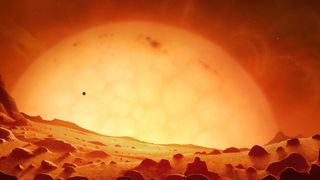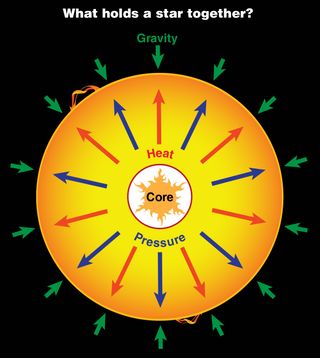When will the sun die?
Here's what will happen when our sun dies, billions of years from now.

If you worry about when the sun will die, never fear: that moment is billions of years away.
The sun gives energy to life on Earth, and without this star, we wouldn't be here. But even stars have limited lifetimes, and someday our sun will die.
You don't need to worry about this solar death anytime soon, though. Like all stars, a churning fusion engine fuels the sun, and it still has a lot of fuel left — about 5 billion years' worth.
Related: What's inside the sun? A star tour from the inside out
When will the sun die?
The sun will begin to die in about 5 billion years when it runs out of hydrogen.
Sun death Q&A with an expert
We asked physicist Frederick C. Bruhweiler a few frequently asked questions about the death of the sun and what it means for our solar system.

Frederick Bruhweiler is a physicist who uses data from space and ground-based instruments and telescopes to model the cosmos. He helped develop the Goddard High Resolution Spectrograph and Space Telescope Imaging Spectrograph, two key instruments on the Hubble Space Telescope, and is currently the lead researcher on multiple NASA-funded research projects.
What will happen when the sun dies?
The sun will end its life as a white dwarf. As a white dwarf, it is essentially a dead star that has exhausted all of the nuclear fuel that it is capable of burning. As a white dwarf, it will slowly cool and fade away to lower and lower temperatures. This is the final state of low-mass stars, including the sun.
Although the sun is a million times the volume of Earth, a white dwarf is roughly the size of our Earth. Most of the white dwarf will consist of a special ultradense state of matter called electron degenerate matter. This is a state where all the electrons are in their lowest possible energy states.
Our sun as a white dwarf will have a core of mostly carbon and oxygen, which is the remnants of burning helium. Around this core will be a thin layer of helium, which will be the leftovers of helium burning. The outside layer will contain a thin layer of unburnt hydrogen. Some white dwarfs do not have this outer hydrogen layer because the thermonuclear burning of hydrogen in their evolution has been complete.
What will happen to Earth when the sun dies?
Earth will probably not even exist when the sun dies. The sun is slowly expanding. In about 5 billion years, the sun will enter the red giant phase. During this phase, the sun makes a transition from burning hydrogen in the core to burning hydrogen around the core, which has been converted into helium by hydrogen burning.
The energy production increases dramatically and forces the star to expand more than 200 times in order to reach a new equilibrium state. Theoretical modeling and observations reinforced with distance determinations from the Gaia spacecraft indicate that the sun could well swallow up the Earth when it reaches its maximum size.
At some point when the sun reaches the tip of the AGB [the asymptotic giant branch], helium burning will commence. In a star like the sun, helium burning occurs by thermal pulses. In each pulse, the sun will undergo significant mass loss.
However, the sun has been undergoing mass loss throughout its entire lifetime. This mass loss rate is rather low in the present sun and is evidenced by the solar wind.
Even now, Earth is losing its water. Interactions with the UV radiation field and particles in the solar wind reaching Earth are dissociating the water in our upper atmosphere. The light hydrogen, especially, can escape the gravitational pull of Earth. Observations with previous space missions and the Hubble Space Telescope show an extensive expanding hydrogen cloud (exosphere) around the Earth. Estimates have suggested that Earth will lose most of its water in a billion years and be much like Mars. Even if the sun doesn’t engulf Earth, the increased luminosity and strong stellar wind in the later phases of its evolution would strip or boil away any remaining atmosphere or ocean. If Earth were to survive, it would be a rocky cinder orbiting a white dwarf.
What will happen to other planets in the solar system when the sun dies?
The big question is, “What will happen to the gas giants” in the outer solar system? The enhanced mass loss in the sun’s later phases of its evolution will definitely strip away the outer atmospheric layers of Jupiter, Saturn, Uranus, and Neptune; to what extent it is hard to say without detailed calculations.
Again, this depends upon the actual mass ejection occurring in the later stages of stellar
evolution and in the fast mass loss phase of the hot pre-white dwarfs. The hot pre-white dwarfs, which remain after the ejection of the stellar envelope and the planetary nebulae phase, will have cores with temperatures of 100,000 K and higher and winds in excess of 2000 km/s. Again, would any of these gas giants survive? If they do, they would only be ghosts of what they once were.
Could a new solar system form after the sun dies?
The ejected material from both the normal evolution and ejected planetary nebula will enrich the interstellar medium with heavy elements resulting from the hydrogen and helium burning processes. This would notably produce carbon, nitrogen, and oxygen, plus s-process elements such as Ba, Zr, and La to name a few.
Clouds of this enriched material combined with that of other stars could form dense clouds, which could later collapse to form the next generation of stars.
Why will the sun die?

Stars like our sun form when a huge cloud of gas (mostly hydrogen and helium) grows so large that it collapses under its own weight. The pressure is so high in the center of that collapsing mass of gas that the heat reaches unimaginable levels, with temperatures so hot that hydrogen atoms lose their electrons.
Those naked hydrogen atoms then fuse together into helium atoms, and that reaction releases enough energy to counter the intense pressure of gravity collapsing the cloud of gas. The battle between gravity and the energy from fusion reactions fuels our sun and billions of other stars in our galaxy and beyond.
But in about 5 billion years, the sun will run out of hydrogen. Our star is currently in the most stable phase of its life cycle and has been since the formation of our solar system, about 4.5 billion years ago. Once all the hydrogen gets used up, the sun will grow out of this stable phase.
What will happen when the sun dies?
With no hydrogen left to fuse in the core, a shell of fusion hydrogen will form around the helium-filled core, astrophysicist Jillian Scudder wrote in an article for The Conversation. Gravitational forces will take over, compressing the core and allowing the rest of the sun to expand.
Our star will grow to be larger than we can imagine — so large that it will envelope the inner planets, including Earth. That's when the sun will become a red giant, which it will remain for about a billion years.
Then, the hydrogen in that outer core will deplete, leaving an abundance of helium. That element will then fuse into heavier elements, like oxygen and carbon, in reactions that don't emit as much energy. Once all the helium disappears, the forces of gravity will take over, and the sun will shrink into a white dwarf. All the outer material will dissipate, leaving behind a planetary nebula.
"When a star dies, it ejects a mass of gas and dust — known as its envelope — into space. The envelope can be as much as half the star's mass," astronomer Albert Zijlstra of the University of Manchester in the United Kingdom, said in a statement. "This reveals the star's core, which by this point in the star's life is running out of fuel, eventually turning off and before finally dying."
Astronomers estimate that the sun has about 7 billion to 8 billion years left before it sputters out and dies. One way or another, humanity may well be long gone by then.
No supernova, no black hole
Our sun isn't massive enough to trigger a stellar explosion, called a supernova, when it dies, and it will never become a black hole either.
In order to create a supernova, a star needs about 10 times the mass of our sun. An object of that size would form a dense stellar corpse called a neutron star after the explosion.
To leave behind a black hole, a supernova must occur in a star with about 20 times the mass of the sun.
Additional resources
Find out what will happen to the Earth when the sun dies, from Live Science. Learn more about how stars form, evolve and die from NASA, and learn more about how the agency studies our sun. Watch a mini documentary on the topic, The Death of the Sun, from PBS Space Time.
Bibliography
- Gesicki, K., "The mysterious age invariance of the planetary nebula luminosity function bright cut-off," Nature Astronomy (2018). https://www.nature.com/articles/s41550-018-0453-9
- NASA, "Our Sun — In Depth," last updated Oct. 15, 2021. https://solarsystem.nasa.gov/solar-system/sun/in-depth/
- NASA, "Why the Sun Won't Become a Black Hole," Sept. 26, 2019. https://www.nasa.gov/image-feature/goddard/2019/why-the-sun-wont-become-a-black-hole
Join our Space Forums to keep talking space on the latest missions, night sky and more! And if you have a news tip, correction or comment, let us know at: community@space.com.
Get the Space.com Newsletter
Breaking space news, the latest updates on rocket launches, skywatching events and more!

JoAnna Wendel is a freelance science writer living in Portland, Oregon. She mainly covers Earth and planetary science but also loves the ocean, invertebrates, lichen and moss. JoAnna's work has appeared in Eos, Smithsonian Magazine, Knowable Magazine, Popular Science and more. JoAnna is also a science cartoonist and has published comics with Gizmodo, NASA, Science News for Students and more. She graduated from the University of Oregon with a degree in general sciences because she couldn't decide on her favorite area of science. In her spare time, JoAnna likes to hike, read, paint, do crossword puzzles and hang out with her cat, Pancake.